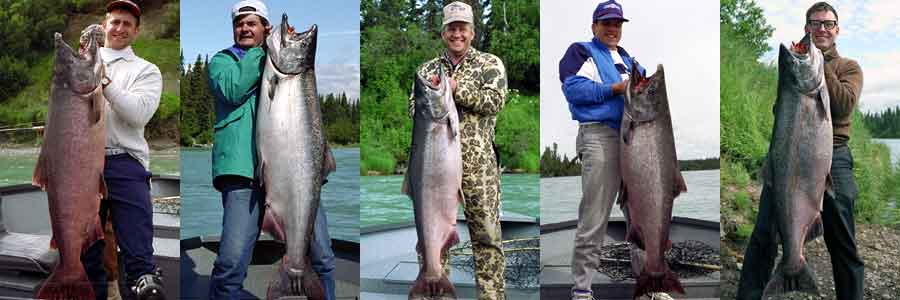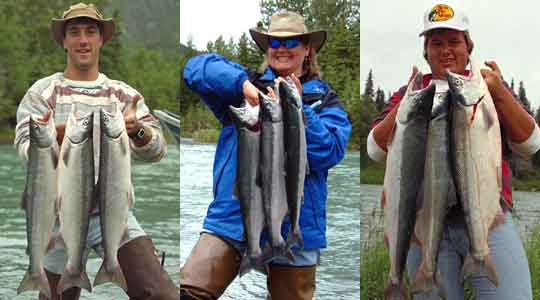

The Kenai is a glacial river draining the central Kenai Peninsula. Originating at Kenai Lake, the Kenai River courses 82 miles through the communities of Cooper Landing, Sterling, Soldotna and Kenai before emptying into Cook Inlet. Sport fishers ply the cold, glacial waters of the Kenai angling for anadromous (sea-run) king, silver, sockeye and pink (in even numbered years) salmon, resident (exclusively fresh water) and anadromous Dolly Varden char and native populations of resident rainbow trout. Lake trout are common in Kenai Lake and Skilak Lake.

With two distinct runs of Chinook returning to the river, the Kenai supports the largest freshwater king salmon fishery in Alaska. First run kings begin returning in early May. The run peaks in mid-June. It is comprised mainly of king salmon returning to tributaries of the Kenai River. The majority of these fish return to the Killey River and the Funny River, both of which flow into the Kenai below Skilak Lake.
A second, larger run of king salmon begins entering the Kenai in early July. The late run is comprised of kings that will eventually spawn in the Kenai River. The peak of the second run traditionally occurs during the latter half of the month of July. The sport fishery for king salmon on the Kenai River is limited to the waters between Skilak Lake and Cook Inlet and is continuous from the first returns of fish in May through the season closure on July 31.

Sockeye (red) salmon enter the Kenai River in two separate runs also. The first run of fish is bound exclusively for the Russian River drainage and begin entering the Kenai in late May. Traditionally, this run moves through the 50 miles of Kenai River below Skilak Lake rapidly, offering minimal sport fishing opportunities. The confluence of the Moose River and Kenai River in Sterling provides the best opportunity for anglers attempting to intercept these first run reds before they arrive at the mouth of the Russian River. The confluence of the Russian River and Kenai River and the previously mentioned Moose River are both designated as "fly fishing only areas". This refers to terminal tackle which must be an unweighted fly with a hook gap of no more than 3/8" and does not mean that anglers must use a fly rod.
The second run of reds begins entering the Kenai River in early July and peaks in late July. Numerous fish are bound to eventual spawning destinations in tributaries throughout the drainage, including the Russian River. Others spawn in the main stem of the Kenai River, between Kenai and Skilak lakes and just below Skilak Lake. During the second run, reds are available throughout the Kenai River.

Silver salmon also migrate into the Kenai River in two distinct runs. First run fish begin appearing in late July. This run peaks middle to late August. Late run silvers enter the river in early September through October.
Pink salmon are available in the fall of even years only (i.e. 1994, 1996, etc.). Their abundance and aggressiveness towards any moving lure provide sport anglers with non stop action.
Rainbow trout are native to the Kenai River, spending the winter in the lakes of the drainage. The best fishing occurs in the section of river upstream from Naptowne Rapids to Skilak Lake and the portion of river designated as a "Trophy Trout" fishery on the scenic Upper Kenai River upstream from Skilak Lake to Kenai Lake. The majority of trout spawn during the low, clear water conditions common in the spring prompting ADF&G to prohibit fishing on the Upper Kenai River from May 1 through June 10 seasonally to protect their spawning endeavors from human interference.
The Kenai River supports both resident and anadromous populations of Dolly Varden. Resident fish are available during the entire year and throughout the river. Anadromous Dolly Varden begin to enter the river in mid summer continuing into September. These fish spawn in the fall and winter over in the river and lakes. In the spring anglers intercept them as they return to Cook Inlet.
![]()